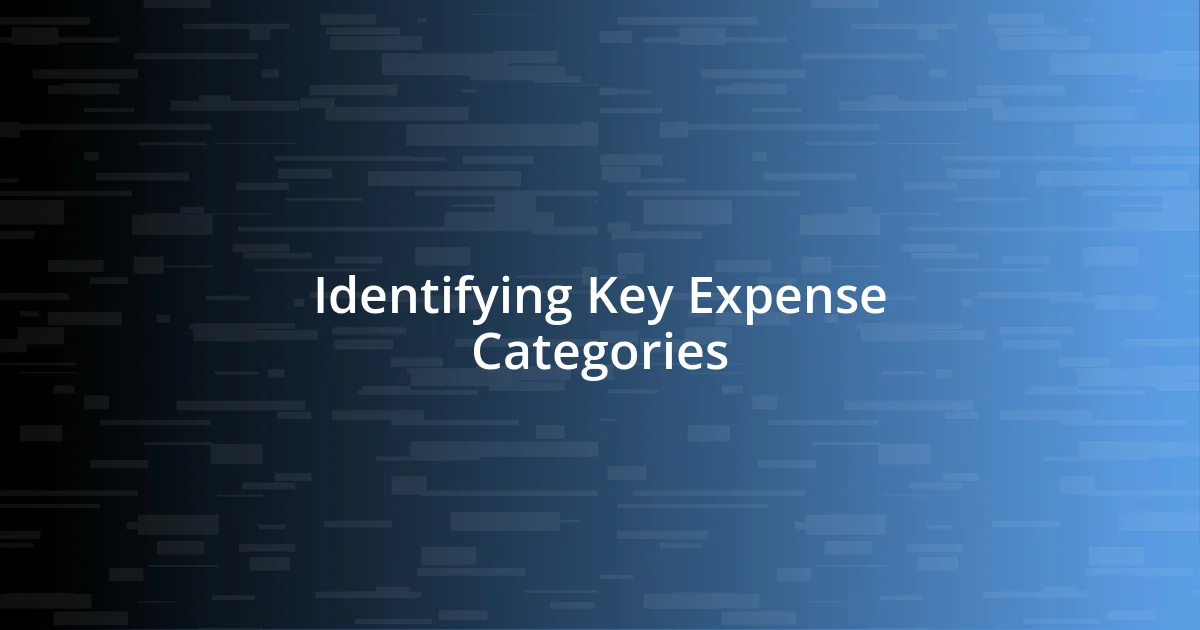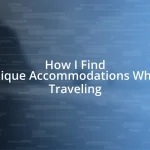Key takeaways:
- Break down travel expenses into categories—accommodations, food, transportation, and activities—while ensuring to account for unexpected costs.
- Use budgeting tools and research affordable destinations to optimize spending, allowing for memorable experiences and flexibility in travel plans.
- Track daily expenses and reflect on spending habits to enhance travel experiences and ensure a balanced budget that accommodates both adventures and cultural immersions.

Understanding Solo Travel Costs
Understanding solo travel costs can feel overwhelming at first, but breaking it down into categories has helped me tremendously. When planning a trip, I often categorize expenses into accommodations, food, transportation, and activities. Have you ever sat down and realized how much a meal abroad can differ from one at home?
I’ve found that accommodations can be the largest portion of my budget. For instance, I once splurged on a quaint, little hotel in Paris, thinking it would be a dreamy experience. While it was stunning, I ended up pinching pennies during the rest of my trip. What I learned is to weigh the cost against the experience—sometimes hostels or budget hotels offer just as much character at a fraction of the price.
Now, let’s talk about unexpected costs. Did you know that fees for local transportation or entrance tickets can sneak up on you? I learned this the hard way on a trip to Barcelona, where I underestimated the costs of traveling around the city. Each metro ride and entry fee added up quickly! Tracking these kinds of expenses in advance is invaluable. It turns the unknown into manageable pieces, allowing for a more fluid journey.

Setting a Budget Outline
When setting a budget outline, I start by estimating costs in each category. I find it helpful to make a spreadsheet—something simple where I can easily adjust numbers as I go along. I remember on my trip to Thailand; I initially thought I could get away with $30 a day. By the end, I was down to my last few dollars after underestimating food and excursions. It’s a reality check that keeps me grounded.
Next, I prioritize my list. What’s non-negotiable? For me, eating local food tops that list. I would gladly sacrifice a fancy hotel room for street food adventures that linger longer in my memory. Convincing myself to allocate more for these experiences often leads to a richer travel experience, like the time I took a cooking class in Vietnam. That splurge became a cherished memory I wouldn’t trade for a few extra nights in the big city.
Finally, I always leave room for flexibility. Travel doesn’t always go as planned, but having a cushion in the budget eases anxiety. For instance, while visiting Iceland, a sudden change in weather forced me to take a guided tour instead of self-driving. I was grateful for that extra wiggle room in my budget; it turned out to be a delightful adventure I hadn’t anticipated.
| Budget Category | Estimated Cost |
|---|---|
| Accommodations | $50-$150 per night |
| Food | $20-$60 per day |
| Transportation | $10-$30 per day |
| Activities | $15-$100 per experience |

Identifying Key Expense Categories
Identifying key expense categories is crucial for effective solo travel budgeting. I remember launching into my first solo trip without a solid handle on these categories. I quickly discovered that almost every destination has its own quirks, like local transportation nuances that can heavily impact your budget. Taking the time to outline my expenses beforehand not only calmed my nerves but also gave me a clearer picture of what I was getting myself into.
Here’s a breakdown of what I typically consider when planning my travels:
- Accommodations: Your chosen place to stay can set the tone for the trip. Whether it’s a chic boutique hotel or a cozy hostel, it’s about comfort and experience.
- Food: Eating like a local is not just about tasting but also about budgeting! From street food to sit-down meals, I usually allocate a solid portion of my budget here.
- Transportation: Don’t overlook the costs associated with moving around, whether by public transport, rideshares, or walking—some cities encourage exploration by foot!
- Activities: Experiences make the journey enriching, but they can vary enormously in cost. Planning for those must-see attractions is essential so you don’t miss out.
Each of these categories holds the potential for surprises—both good and bad. Like that time I signed up for a pricey vineyard tour in Italy, only to find the most spectacular views were free to access with a simple hike. Things like this remind me to stay adaptable and curious!

Researching Affordable Destinations
When diving into researching affordable destinations, I always start with the big picture. I scan various travel blogs and forums, seeking places that fit my budget but also excite my wanderlust. For instance, when I stumbled across the idea of exploring Eastern Europe, I was thrilled to find that cities like Budapest and Prague offered a vibrant culture without emptying my wallet. Have you ever discovered a hidden gem that transformed your travel plans? It’s like finding treasure!
Another strategy I find effective is using price comparison websites. They help me gauge average costs for accommodations and activities before I even set foot in a location. On my journey to Mexico City, I discovered that staying in a well-rated boutique hotel in a trendy neighborhood was surprisingly affordable, all while being close to incredible street food. It made me realize how essential it is to research not just prices, but also the experiences those prices can afford you.
Lastly, joining social media groups focused on budget travel has proven invaluable for me. Fellow travelers often share their insights on less-trafficked and budget-friendly locales. I remember reading about a friend’s experience in Albania, a destination I hadn’t previously considered. Her stunning photos and enthusiastic descriptions convinced me to add it to my travel list, reminding me that sometimes, the most memorable adventures happen in the most unexpected places. Have you ever been inspired to travel somewhere just because someone shared their story? I know I have!

Saving Money on Travel
Finding ways to save money while traveling is like a rewarding puzzle that I genuinely enjoy solving. One of my favorite tricks is to book flights during off-peak times. I once snagged an incredible deal on a flight to Thailand by flying mid-week instead of during weekends. The thrill of saving that much, coupled with the adventure awaiting me, made the experience even sweeter. Have you ever experienced that rush of discovering a great deal?
Another strategy I regularly employ is cooking my own meals, especially in accommodations with kitchen facilities. I remember one trip in Portugal where I bought fresh ingredients at a local market and whipped up a traditional dish. Not only did it save money, but it also allowed me to connect with local culture in a unique way. Cooking is not just a frugal choice; it transforms meals into memorable experiences. Have you considered how your dining habits could enhance your travels?
Lastly, I always seek out free activities and events in the towns I visit. On my last trip to Barcelona, I stumbled upon a vibrant street festival that was completely free to attend. Exploring local parks, markets, and art galleries often leads to unexpected delights that don’t cost a dime. It’s a reminder that sometimes the best experiences come without a price tag. What free experiences have left a mark on your travels?

Using Budgeting Tools Wisely
Utilizing budgeting tools wisely is all about finding the right fit for your travel style. I often turn to apps that help manage my travel expenses in real-time. For instance, when I traveled to Japan, I used a spending tracker that not only categorized my expenses but also alerted me when I was nearing my budget limit. Have you ever been caught off guard by an overspend? That app saved me from a few last-minute scrambles!
Another resource I swear by is the plethora of online calculators for estimating trip costs. Before my recent trek to Iceland, I inputted my anticipated expenses for accommodations, food, and experiences into one of these calculators. It gave me a clearer picture of my budget and even highlighted areas where I could cut back. This little exercise helped me prioritize experiences I truly valued, like soaking in the Blue Lagoon. Have you tried visualizing your budget this way?
I also love leveraging community-driven budgeting tools like shared spreadsheets with travel buddies. On a group trip to Costa Rica, we created a dynamic spreadsheet to track our shared costs in real-time. It made splitting expenses so much easier and more transparent, leading to less stress and more focus on enjoying the breathtaking scenery together. How have you worked with others to keep your travel finances in check? It’s all about making budgeting a collaborative effort!

Tracking Spending During Trips
Keeping tabs on my spending while traveling has become second nature to me. During my recent adventure in Greece, I made it a habit to jot down my expenses each evening. There was something satisfying about seeing how my budget aligned with my daily experiences. This simple act not only kept me mindful but also allowed me to indulge guilt-free on a delicious meal without worrying about overspending. Have you ever stopped to consider the power of reflection at the end of the day?
I often find that tracking my spending enhances my overall travel experience. For instance, on my last solo trip to Colombia, I used a budgeting app that visually represented where my money was going. This feature helped me realize that while I was splurging on breathtaking excursions, I was skimping on nightlife and cultural events, which are equally important. That realization led me to adjust my spending habits on the fly, ensuring I balanced both adventure and cultural immersion. How do you find a balance in your travel spending?
While tracking every penny can feel tedious, I’ve learned to make it fun. I treat it like a game: every time I log an expense, I can think about what incredible experience that money enabled. On a road trip through the Pacific Northwest, for example, each gas station visit was another opportunity to reflect on the beauty I’d seen. It became a moment to celebrate the journey rather than just a chore. What’s your strategy for transforming budgeting from a burden into a rewarding part of your adventure?














